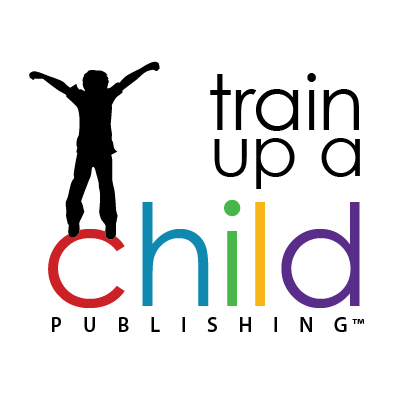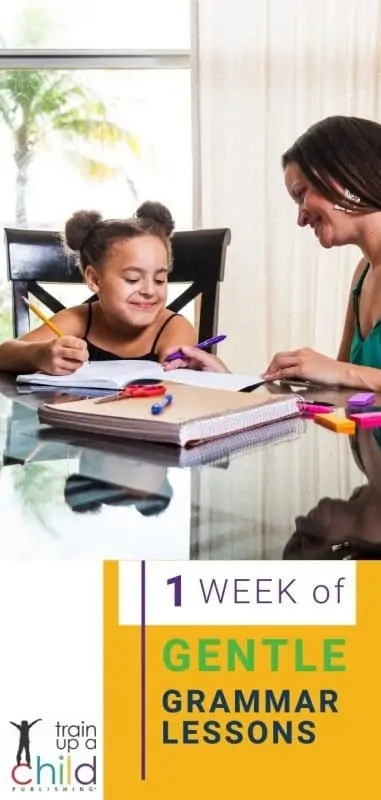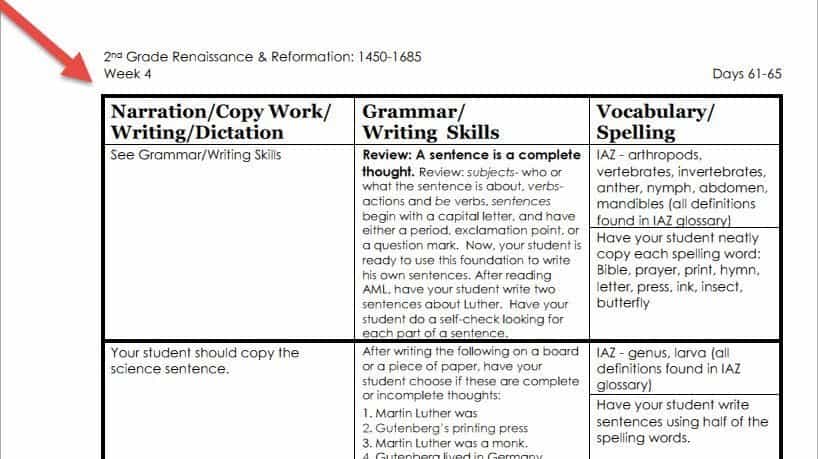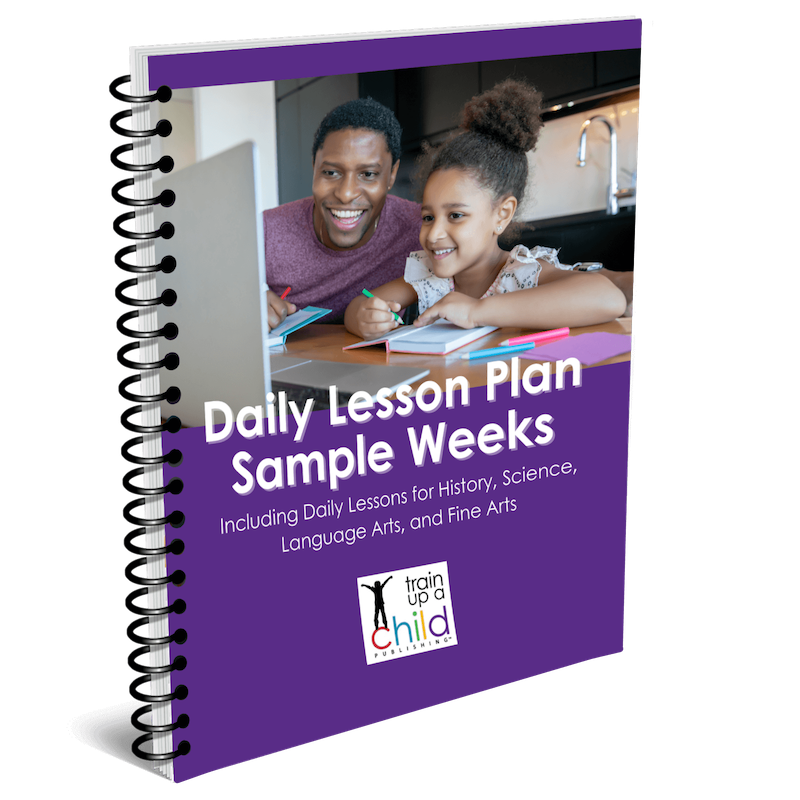A Week of Gentle Grammar Lessons

Did you see a Gentle Grammar Lesson from Charlotte Mason’s writings? That post demonstrates how simple it can be to teach grammar to children using the books they are reading for history and science. To see this demonstrated in more detail, I’m including a week of gentle grammar lessons in this post below.
This week of lessons is taken from the Ancients Unit of our 4th Grade Daily Lesson Plans. (This is at the beginning of the school year.) Note that this method integrates grammar study with copywork, handwriting, history, and science.
We homeschool moms like to get a lot of bang for our buck by integrating as many subjects as is realistic. It makes the most of your time, and brain/learning research shows us that integrating subjects helps kids learn better.
And if you’ve read this blog for any length of time, you’ve heard me say that our purpose here is to help you learn how to bring your children’s home education to life and help you to have a happy, thriving home. When you can use simple teaching methods that save time and make learning stick, it’s time well spent!
And studying grammar and language arts, in general, using this method means you aren’t buying yet another curriculum to do it!
Note that this post includes affiliate links to homeschool tools we use and love. Should you purchase something using an affiliate link, we might make a small commission on your purchase at no extra cost to you. Thank you for supporting us in this way!
Before the Lesson…
Before starting the lesson below, ensure your child understands that a sentence is a group of words combined to make a complete thought. If you haven’t taught that yet, here’s that lesson again to help you teach your kids what a sentence is.
One more thing.
How to prepare your kids’ copy work
I recommend using Notebooking Pages to make all of your copy work pages, especially if your student is a new writer or just learning cursive.
Or if you write like me. This is why I type almost everything.
Anyway, this program allows you to create a copywork model printed or in cursive, with the type and size of lines that will work for your child at his or her stage of development.
If you’re going to homeschool for a while, getting a lifetime membership gives you TONS of already made notebooking pages and the ability to make copy work examples for your children quickly.
But before you buy anything, get the large pack of free pages they give you here.
It’s fast, easy, and gives your children a perfectly formed example to follow.
Okay, back to our week of gentle grammar lessons!
Day One
Before the grammar lesson, as a copywork assignment, ask your student to neatly copy the following sentences taken from Exodus by Brian Wildsmith. (This is a book you are reading for history during the Ancients unit):
- A Hebrew woman gave birth to a son.
- Pharaoh’s daughter came down to the river to bathe.
- The woman took the baby and nursed him.
- Review and have your student make any necessary corrections.
- Discuss with your student:
Let’s talk further about sentences and use a new word – predicate: A complete sentence is made up of a subject and a predicate. A subject tells whom or what the sentence is about, while the predicate tells something about the subject.
- Use your student’s copywork from today to demonstrate the division of subject and predicate. (The answer key for this exercise is included in the curriculum: 1. A Hebrew woman / gave birth to a son. 2. Pharaoh’s daughter / came down to the river to bathe. 3. The woman / took the baby and nursed him.)
- As you discuss this with your student, continue to reinforce the difference between the subject and the predicate in a sentence. Look at other simple sentences and have your student come up with some on his own, and divide them into subject and predicate.
Day Two
Before the grammar lesson, as a copywork assignment, ask your student to neatly copy the following taken from Mara, Daughter of the Nile by Eloise McGraw (another history book that does double-duty as a literature book).
- Doorways were blue-black in white buildings.
- Sweating porters hurried in and out.
- Nekokh chewed his lip.
- Review and have your student make any necessary corrections.
- Discuss with your student:
Remember yesterday when we talked about subjects and predicates? What do you remember from our discussion? A complete sentence is made up of a subject and a predicate. The subject tells whom or what the sentence is about, and the predicate tells something about the subject. Yesterday we divided three sentences from one of your history books into subjects and predicates. Let’s do that again. Where would you divide your three sentences from Mara, Daughter of the Nile?
- If your student has difficulty distinguishing the subjects from the predicates, ask, “Whom or what is this sentence about?” After you figure out the subject, it’s easy to see the answer to the other question, “What does the sentence say about the subject?”
- Have your student divide today’s copywork sentences into subjects and predicates.
- Check your student’s sentences with the provided answer key: 1. Doorways / were blue-black in white buildings. 2. Sweating porters / hurried in and out. 3. Nekonkh / chewed his lip.
Day Three
Before the grammar lesson, ask your student to neatly copy the three sentences from the day’s science concepts and one sentence from history:
- Matter is made up of molecules.
- Elements combine to make molecules.
- Properties are the signatures of elements and molecules.
- Altars were often built on the sites of important events.
- Review and have your student make any necessary corrections.
- Ask your student to divide today’s copywork sentences into subjects and predicates.
- By this time, your student should feel comfortable dividing simple sentences into subjects and predicates, but if not, continue asking your student: “Who or what is this sentence about?” then, once you’ve figured out the subject together, ask, “What does the sentence say about the subject?”
Day Four
- Have your child(ren) look for five basic sentences in today’s reading of Old Testament Days by Nancy Sanders (a history and activity book).
- Once they find five, have them copy each sentence neatly.
- Now have your student(s) divide them into subjects and predicates.
- Check and make sure your student divided them correctly.
Day Five
- Have your student tell you what a subject and a predicate are.
- Have your student copy the writing/grammar rule for this week: A complete sentence is made up of a subject and a predicate.
In addition, it’s helpful to give your student space in a three-ringed binder to write grammar rules. A lined composition book works well, too. Review the rules periodically, especially if you notice a particular recurring error.
And that is all there is to it!
Want to see more examples of a week of grammar lessons?
If you would like to see more examples just like this week, take a look at other daily lesson plan sample weeks. Go to our Daily Lesson Plans Page, and click on “Sample.” Then look for the language arts page that looks like this:
You will find all the language arts tasks for that particular week there.
Why does this method of teaching grammar, and language arts in general, work so well?
- Because it’s so SIMPLE.
- And because you reinforce it with copywork and repeat it several times to ensure your children remember the concept.
Consequently, because these are simple, short lessons, your child will be able to focus and understand them! You teach one simple skill at a time, and one skill builds on another.
Again, It’s practical for you, too, since you don’t have to buy a separate language arts curriculum and take the time to teach it.
Additionally, teaching language arts this way allows you to integrate it with your history and science reading, so it makes sense to your student because he’s already familiar with the books.
So you are just adding new information (the language arts part) instead of trying to teach language arts “in isolation,” which isn’t as effective, according to science!
Using this natural, gentle way of teaching grammar using the books you’re already reading for history, science, and literature is the easiest, most effective way to teach grammar to your kids. For more examples, see our Daily Lesson Plan sample weeks (click on the level you’re interested in and scroll down until you get to the sample.)
Easy!! Try it!




